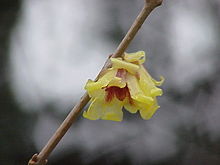Chimonanthus
| Chimonanthus | |
|---|---|
 |
|
| Chimonanthus praecox flower | |
| Scientific classification | |
| Kingdom: | Plantae |
| (unranked): | Angiosperms |
| (unranked): | Magnoliids |
| Order: | Laurales |
| Family: | Calycanthaceae |
| Genus: |
Chimonanthus Lindl. (1819) |
| Type species | |
|
Chimonanthus praecox |
|
| Species | |
|
Chimonanthus nitens Oliv. |
|
| Synonyms | |
|
Meratia Loiseleur-Deslongchamps |
|
Chimonanthus nitens Oliv.
Chimonanthus praecox (Linn.) Link
Chimonanthus salicifolius Hu
See text.
Meratia Loiseleur-Deslongchamps
Sources: ING, IPNI, CPN
Chimonanthus (wintersweet) is a genus of flowering plants in the family Calycanthaceae, endemic to China. It is also grown in Iran, called "ice flower" (Gole' Yakh) and probably imported from China. The genus includes three to six species depending on taxonomic interpretation; three are accepted by the Draft Flora of China. The name means winter flower in Greek.
They are deciduous or evergreen shrubs growing to 2–13 m tall. The leaves are opposite, entire, 7–20 cm long and 3–7 cm broad. The flowers are 2–3 cm wide, with numerous spirally-arranged yellow or white tepals; they are strongly scented, and produced in late winter or early spring before the new leaves. The fruit is an elliptic dry capsule 3–4 cm long.
Source: MBG
Chimonanthus praecox, "wintersweet", is the only species widely grown as an ornamental plant, for its spicily scented winter flowers; these are also used in floristry as cut flowering branches, which can also be forced as with forsythia. The petals are quite waxy. The plant prefers medium exposure to sunlight or high dappled shade, a fresh climate (hardy to USDA Zone 7), and soft, acidic permeable ground not waterlogged in winter. A protected, south-facing wall encourages early flowering, and a position should be chosen where its spicy perfume can be appreciated while coming and going from the house. Space needs to be allowed for its eventual spread to 3 m (10 ft), since untimely summer pruning to keep an ill-sited shrub in check will sacrifice flowering the following winter.
...
Wikipedia
